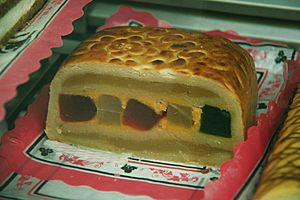Pan de Cádiz facts for kids
 |
|
| Type | Dessert |
|---|---|
| Place of origin | Spain |
| Region or state | Andalusia |
| Main ingredients | Marzipan, candied fruit |
Pan de Cádiz (say "Pahn day Cah-deez") is a delicious sweet treat from Cádiz, a city in Spain. It's also sometimes called turrón de Cádiz. This special dessert is made mostly from marzipan and candied fruit. Marzipan is a sweet paste made from ground almonds and sugar.
The name "Pan de Cádiz" means "Bread of Cádiz" in Spanish. It probably got this name because it looks like a rectangular loaf of bread. People in Spain often enjoy this yummy confection during the Christmas holidays.
What is Pan de Cádiz Made Of?
Pan de Cádiz is a type of confectionery, which means it's a sweet food. The main ingredients are always marzipan and candied fruit.
- Marzipan: This is a sweet dough made from finely ground almonds, sugar, and sometimes egg whites. It's very popular in many European desserts.
- Candied Fruit: These are fruits that have been preserved by soaking them in sugar syrup. This makes them sweet and chewy. Common candied fruits in Pan de Cádiz might include oranges, cherries, or melon.
There are many different ways to make Pan de Cádiz. Each recipe might have its own special touch, but the basic idea stays the same: a tasty mix of marzipan and colorful candied fruits.
A Sweet History
Pan de Cádiz is a relatively new dessert compared to some other Spanish sweets. It was created in the 1950s by a talented pastry chef named Antonio Valls Garrido. He first sold this unique treat in his pastry shop, called Viena.
Some people think that the idea for Pan de Cádiz might have come from older marzipan rolls. These rolls, also filled with fruit, were made in Cádiz during the 1800s. Antonio Valls Garrido likely took this idea and made it into the popular "bread" shape we know today.
When is Pan de Cádiz Eaten?
While you can find Pan de Cádiz at other times, it is most often enjoyed during the Christmas season in Spain. It's a traditional holiday dessert that families share. It's a sweet way to celebrate and enjoy the festive spirit.
See also
 In Spanish: Pan de Cádiz para niños
In Spanish: Pan de Cádiz para niños

